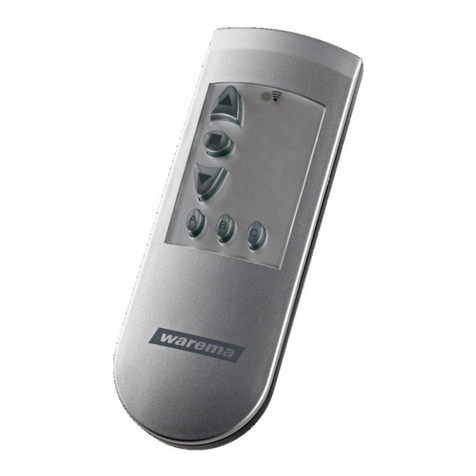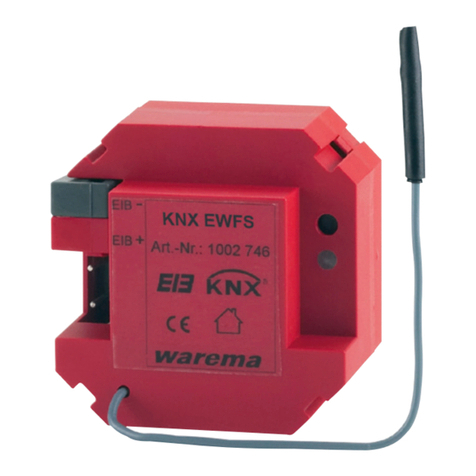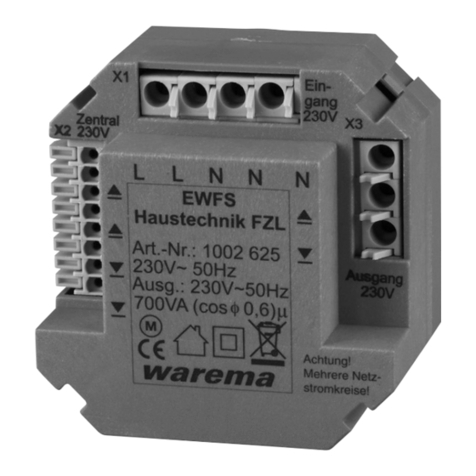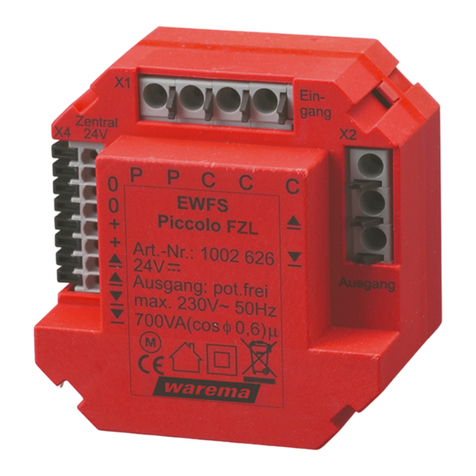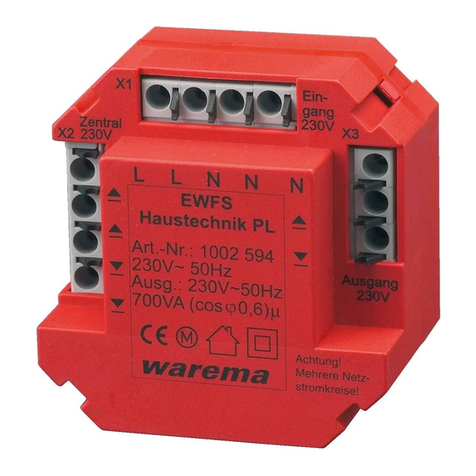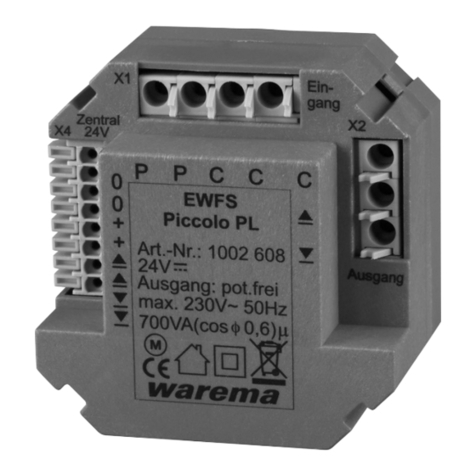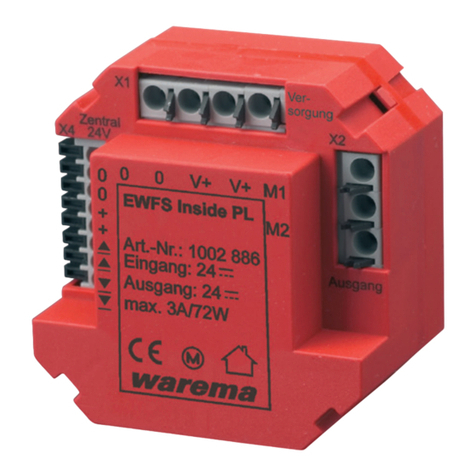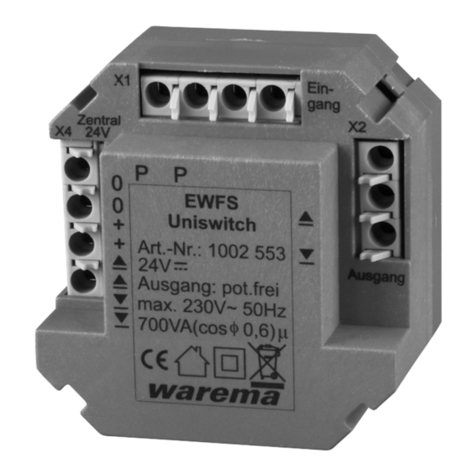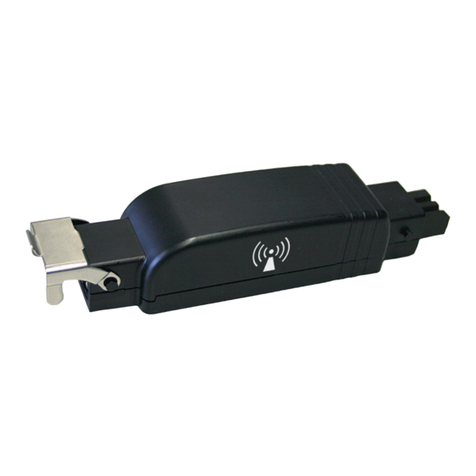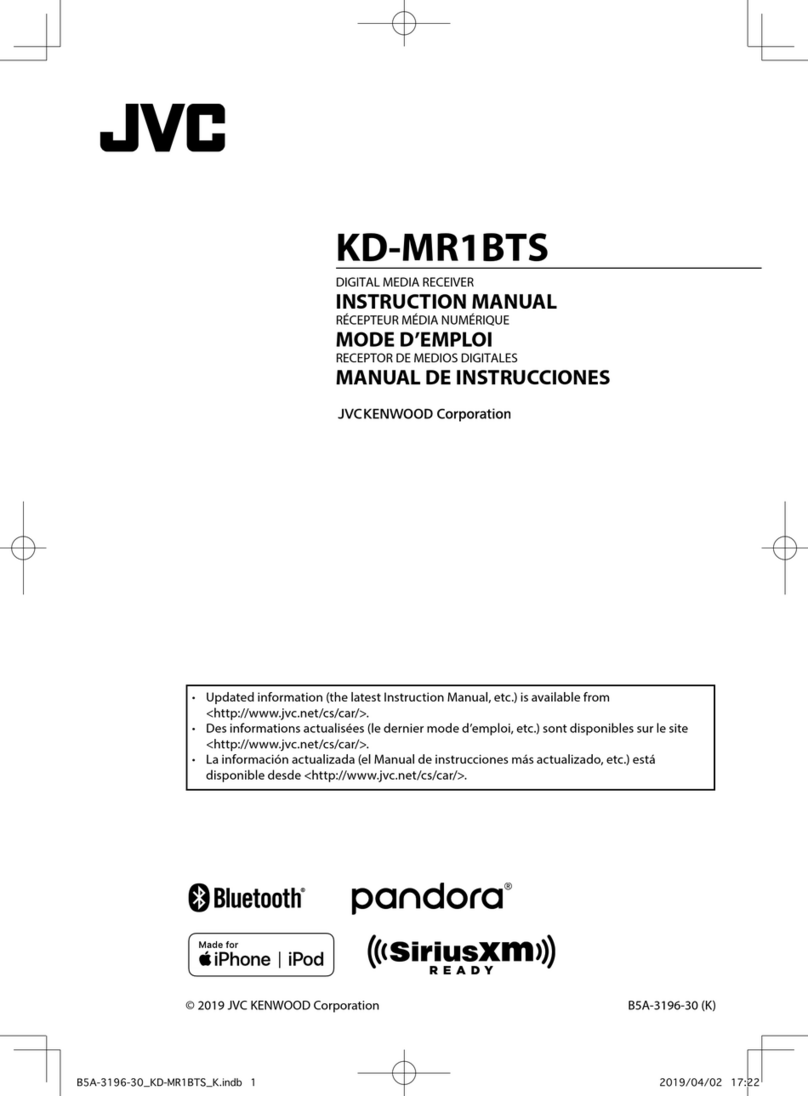
warema_890580_alhb_en_v4•2021-09-01We reserve the right to carry out improvements
2
Programming
For commissioning, the device is equipped with a pro-
gramming button and a red status LED.
nPress the programming button to put the device into
programming mode. The red LED lights up when pro-
gramming mode is active. The device is programmed
on a PC with the corresponding software. The software
ends the programming mode automatically and the red
LED goes out.
nIf you wish to end the programming mode prematurely,
press the programming button again. The red LED
goes out.
For commissioning, you need the EWFS Receiver
and the WAREMA EWFS Monitor software. The
WAREMA EWFS Monitor can be downloaded from
www.warema.de.
Operation
The KNX EWFS Receiver is operated with trained EWFS
Hand-held transmitters or EWFS Wall-mounted transmitters.
Please refer to the KNX EWFS Receiver software documen-
tation for the exact programming and operating procedure.
Function
A detailed description of the functions is provided in the
software documentation of the control system.
Heartbeat function for a learned EWFS Weather station
The weather station cyclically sends a so-called "heartbeat
pulse" to all receivers into which the weather station is
learned. Unfavourable conditions (eco weather station:
longer periods of darkness or soiling of the solar panel;
plus weather station: power failure) may cause the weather
station to fail temporarily. In this case, the weather station
does not emit heartbeat pulses. The receiver may also
fail to receive a heartbeat pulse from a learned weather
station when the installation situation is unfavourable.
This is considered by the receiver to be a weather station
failure and the sun shading system is raised for safety
reasons. In this phase, the sun shading system cannot
be operated as usual: When it is lowered manually,
the movement is stopped automatically after approx.
5seconds. Pressing the button again causes the same
reaction. The sun shading system can be raised as usual.
This is a safety function and not an error.
Maintenance
There are no parts within the device that require
maintenance.
Please consult your system integrator if operating
problems arise.
Contact your WAREMA dealer if repair is required.
Cleaning
Clean the housing with a soft, dry cloth. Do not use deter-
gents, cleaning agents, solvents, abrasive substances or
steam cleaners!
Liability
Failure to comply with the product information in these
instructions and use of the device in a manner that
contravenes its intended use and purpose may result in
the manufacturer refusing to honour warranty claims for
product damage. In this case, liability for consequential
harm to persons or damage to property will also be
excluded. Follow also the instructions in the operating
manual of your sun shading system. The automatic
or manual operation of the sun shading system when
iced over as well as using the sun shading system
during severe weather may cause damage and must be
prevented by the user by taking suitable precautions.
Disposal
After use, the device must be disposed of according to
legal regulations or turned in to your local recycling centre.
KNX EWFS
Art.-Nr.: 1002 746
EIB +
EIB
‒
JY(St)Y 2x2x0.8 mm ø
KNXJY(St)Y 2x2x0.8 mm ø
KNX
Programming button
LED
Fig. 2 KNX EWFS Receiver wiring diagram
Technical data
KNXEWFS Receiver Min. Typ. Max. Unit
24 V DC supply (via the KNX bus)
Operating voltage 20 33 V DC
Current consumption 10 25 mA
Power consumption 0.3 0.8 W
HF receiver
Receive frequency
ASK (OOK) 433.92 MHz
Ambient conditions
Operating temperature -20 20 60 °C
Storage temperature -25 20 70 °C
Humidity
(non-condensing) 10 40 85 %RH
Enclosure
Dimensions in mm
(WxHxD) Overall device
without antenna
48.5 x 30 x 48.5
Length of antenna in mm 170
Weight in g (overall device) 38
Degree of protection/
safety class IP20 / III
Bus interface Transceiver FZE 1066
Miscellaneous
Location of use Clean ambient conditions
Conformity declaration
Can be viewed at www.warema.com/ce
This device complies with the EMC directives for use in residen-
tial and commercial areas.
WAREMA Renkhoff SE declares herewith that this radio sys-
tem type KNX EWFS Receiver is in compliance with the guideli-
ne 2014/53/EU.
Article numbers
KNX EWFS Receiver 1002 746
EWFS Receiver 1002 049
WAREMA Renkhoff SE
Hans-Wilhelm-Renkhoff Strasse 2
D-97828 Marktheidenfeld
Germany
The affixed CE test symbol confirms that the devices in
their typical configuration correspond to the low voltage
and EMC guidelines of the European Union.
EIB and KNX are registered trademarks of the KNX Asso-
ciation. Other brand names and product names are trade-
marks or registered trademarks of other companies.
